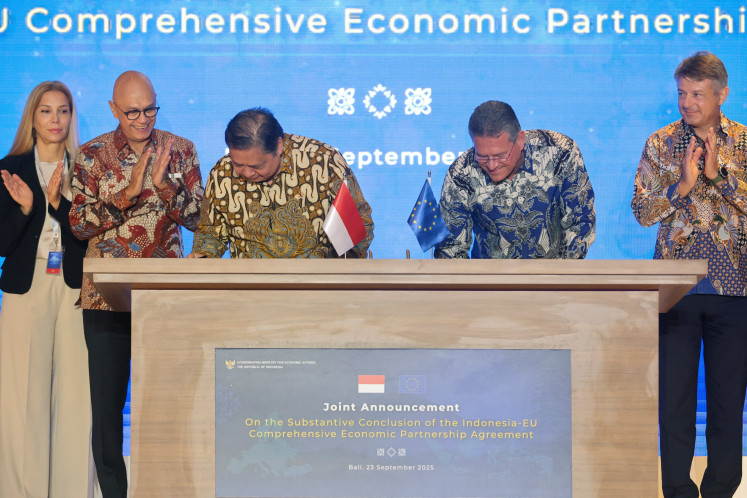Popular Reads
Top Results
Can't find what you're looking for?
View all search resultsPopular Reads
Top Results
Can't find what you're looking for?
View all search resultsClimate change reduces areas of rainfall in West Java
Scientists at the National Aeronautics and Space Agency (LAPAN) have linked climate change to the gradually diminishing areas of rainfall in a number of regions across West Java over the last 100 years
Change text size
Gift Premium Articles
to Anyone
S
cientists at the National Aeronautics and Space Agency (LAPAN) have linked climate change to the gradually diminishing areas of rainfall in a number of regions across West Java over the last 100 years.
LAPAN’s Atmosphere and Climate Applied Science Center head Thomas Djamaluddin said scientists had compared data in the first 30 years of the 20th century (1900-1930) and the last 30 years of the 20th century (1973-2002).
Based on the data, heavy annual rainfall of about 3,200 millimeters was occurring regularly in West Java in the early part of the 20th century in Bogor and its surrounding areas, including southern parts of Garut and Tasikmalaya, and spreading as far east as Ciamis, which borders Central Java.
However, data on the intensity of rainfall in the last 30 years of the century showed that the only area in the province that experienced regular intense rainfall was Bogor.
“Residents in West Java should respond by adapting to the new phenomenon because water supplies during the rainy season have gradually reduced,” Thomas told The Jakarta Post in Bandung.
Average annual rainfall across West Java has also dropped from 2,500 ml in the early 20th century to 2,000 ml today.
Thomas said the significant drop in rainfall could also take place in other areas in Indonesia.
“We have to analyze how much rainfall has decreased in other areas, so as to determine steps to be taken in accordance with conditions in respective areas,” said Thomas, the 11th LAPAN professor.
LAPAN researchers have also been investigating the effects of climate change on instances of acid rain in 12 cities in Java, Kalimantan and East Nusa Tenggara.
Acid rain occurs when the acidity, or pH level, of rainwater is below 5.6 points.
Thomas suspected there may be a correlation between the rising sea level, which contributed to chlorine elements of up to 50 percent, and the occurrence of acid rain.
The dominant factor leading to acid rain is the presence of huge levels of chlorine, as well as nitrate and sulphate from vehicle gas emissions.
The rising sea level is also believed to have contributed to the phenomenon, evident from a number of cities where air pollution levels are low but where acid rain is present. “Such as Padang in West Sumatra, Kupang in East Nusa Tenggara, Banjarbaru in Kalimantan and Serpong in Tangerang, Banten, where their rainwater pH level is below 5 points,” said Thomas.
LAPAN came to the conclusion that global warming was in part caused by the rising sea surface temperature, which causes a rise in chlorine ion levels, abundant in the sea, releasing them into the atmosphere. The chlorine ions are then mixed with rainwater to form acid rain.
The acid rain phenomenon requires further investigation, added Thomas.
“We must find the causes because the phenomenon relates to mitigation efforts that need to be carried out. If the causes are clear, then mitigation efforts could be implemented effectively to avoid huge losses,” said Thomas.










